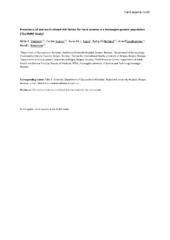| dc.contributor.author | Vindenes, Hilde Kristin | en_US |
| dc.contributor.author | Svanes, Cecilie | en_US |
| dc.contributor.author | Lygre, Stein Håkon Låstad | en_US |
| dc.contributor.author | Hollund, Bjørg Eli | en_US |
| dc.contributor.author | Langhammer, Arnulf | en_US |
| dc.contributor.author | Bertelsen, Randi Jacobsen | en_US |
| dc.date.accessioned | 2019-01-02T12:51:32Z | |
| dc.date.available | 2019-01-02T12:51:32Z | |
| dc.date.issued | 2017-10 | |
| dc.Published | Vindenes HK, Svanes C, Lygre SH, Hollund BE, Langhammer A, Bertelsen R. Prevalence of, and work-related risk factors for, hand eczema in a Norwegian general population (The HUNT Study). Contact Dermatitis. 2017;77(4):214-223 | eng |
| dc.identifier.issn | 0105-1873 | |
| dc.identifier.issn | 1600-0536 | |
| dc.identifier.uri | https://hdl.handle.net/1956/18809 | |
| dc.description.abstract | Background: Chemical exposures at work and at home may cause hand eczema. However, this has been scarcely described for Norway. Objectives: To investigate the prevalence of, and occupational risk factors for, hand eczema in Norway. Methods: Among 50 805 respondents (aged ≥20 years) to the third Nord‐Trøndelag Health Study (HUNT3), 5757 persons reported ever having hand eczema, and 4206 answered a hand eczema questionnaire. Results: The lifetime prevalences of hand eczema were 8.4% in men and 13.8% in women (p < 0.001), with onset at age ≤10 years in 24% (men) and 20% (women), and onset at age ≥30 years in 37% (men) and 25% (women) (p < 0.001). Work‐related hand eczema affected 4.8% of the population, and was most frequently associated with health/social work (29%) and occupational cleaning (20%) in women, and with farming (26%) and industrial occupations (27%) in men. Cleaning detergents (75%) and other chemicals (36%) were the most common exacerbating factors. Conclusions: The prevalence of hand eczema was 11.3%, and that of work‐related hand eczema was 4.8%. Hand eczema was more common in women than in men, but with a later onset in men. Cleaning detergents were the most common aggravating factors. A large proportion of the Nord‐Trøndelag population is employed in farming, providing the possibility to identify farming as an important risk factor for hand eczema. | en_US |
| dc.language.iso | eng | eng |
| dc.publisher | Wiley | eng |
| dc.subject | atopic dermatitis | eng |
| dc.subject | Epidemiology | eng |
| dc.subject | hand eczema | eng |
| dc.subject | HUNT | eng |
| dc.subject | occupational | eng |
| dc.title | Prevalence of, and work-related risk factors for, hand eczema in a Norwegian general population (The HUNT Study) | en_US |
| dc.type | Peer reviewed | |
| dc.type | Journal article | |
| dc.date.updated | 2018-06-06T14:19:02Z | |
| dc.description.version | acceptedVersion | en_US |
| dc.rights.holder | Copyright 2017 John Wiley & Sons A/S | |
| dc.identifier.doi | https://doi.org/10.1111/cod.12800 | |
| dc.identifier.cristin | 1508678 | |
| dc.source.journal | Contact Dermatitis | |
